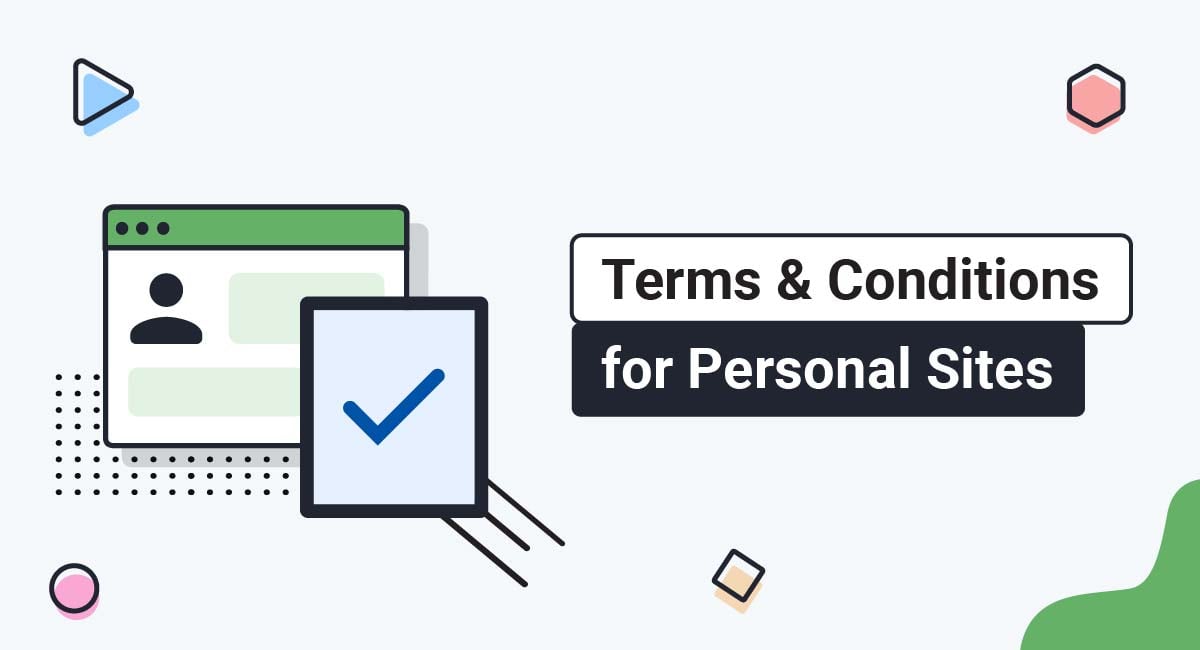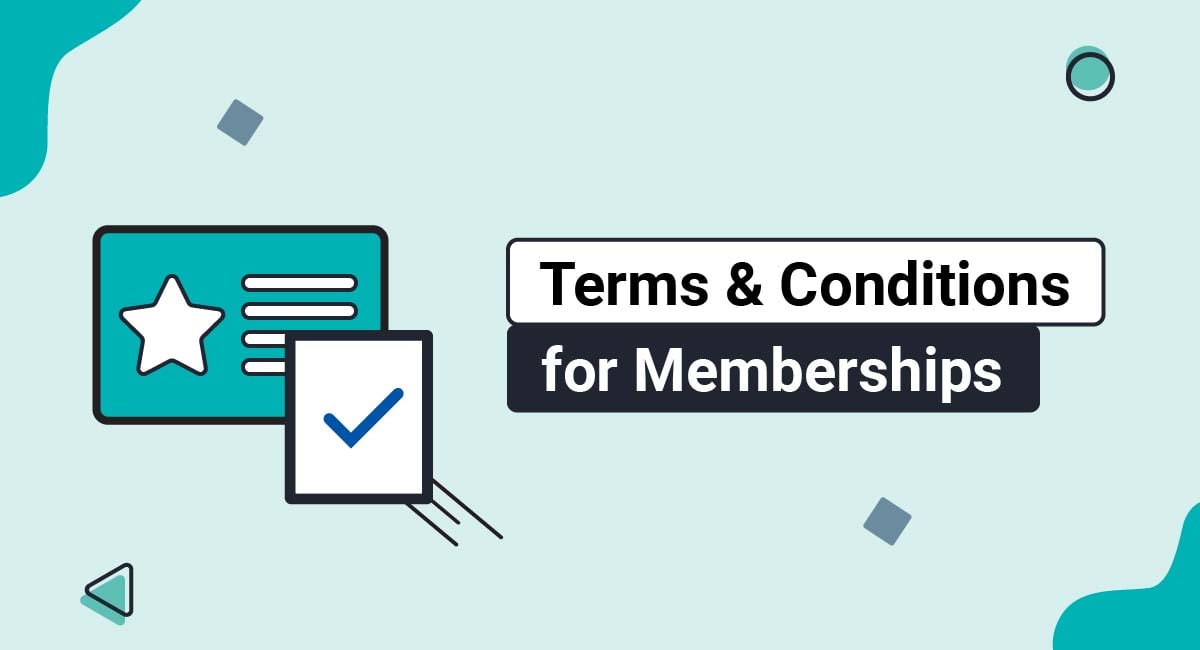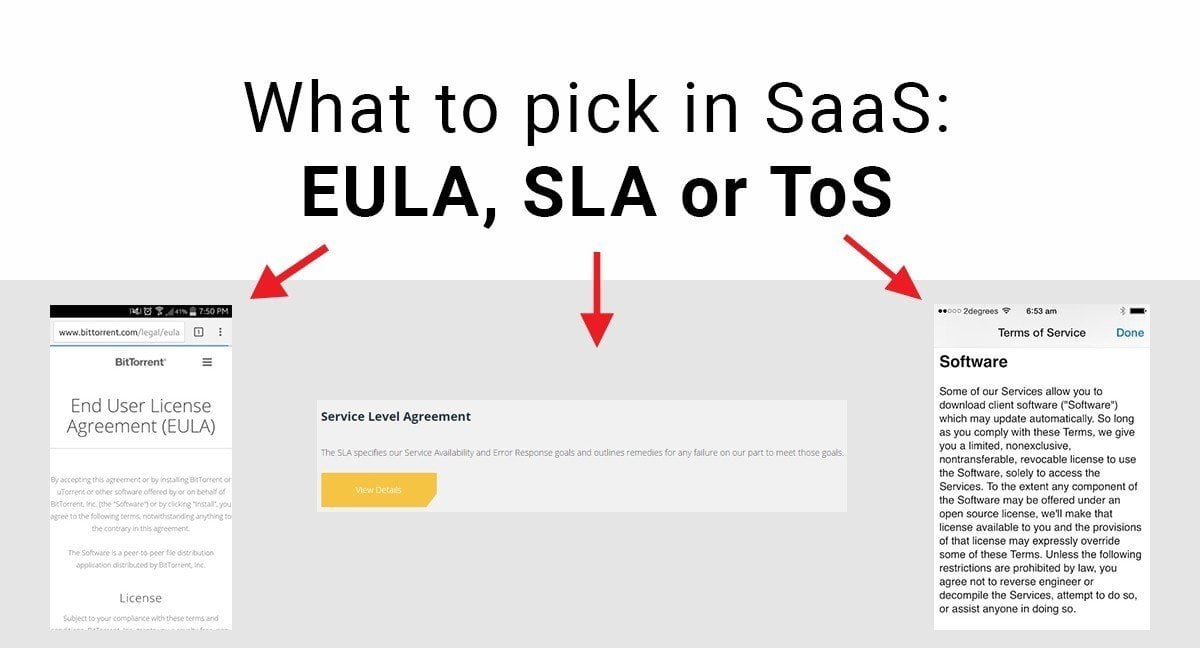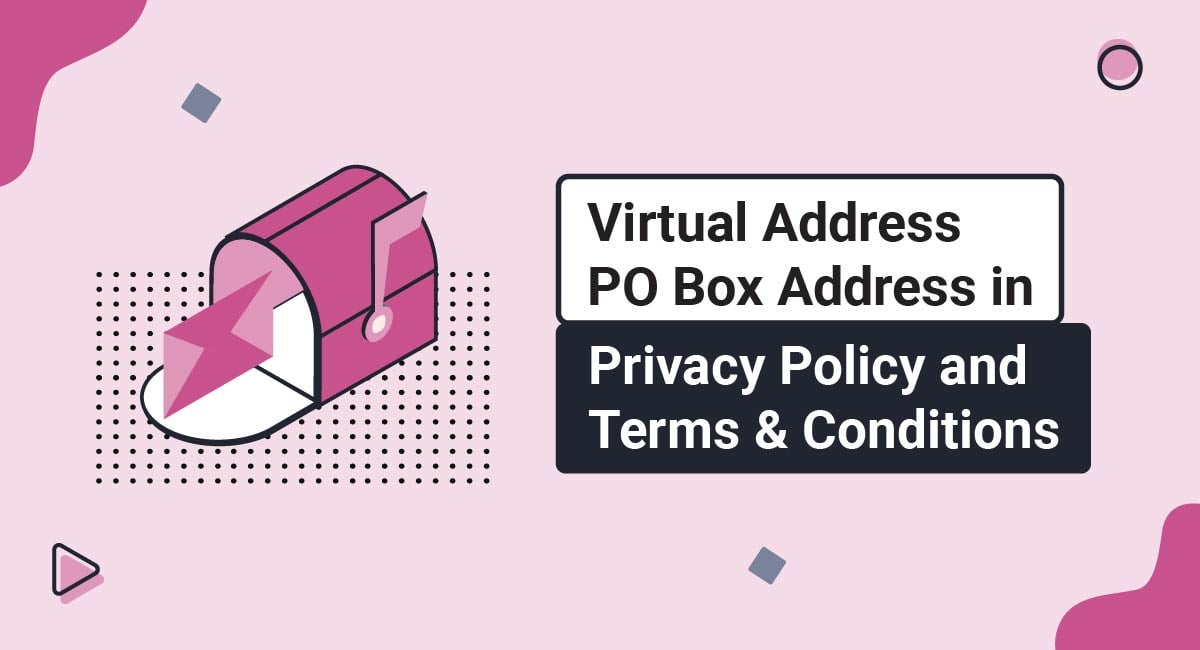When you create a personal website, you are responsible for setting the terms and the conditions of using that site.
A Terms and Conditions agreement (T&C), also known as a Terms of Service or Terms of Use, establishes the rules that users must follow when accessing and using your site. It also summarizes your rights and responsibilities as well as those of the website's users, amongst other benefits.
In this article, we will discuss the benefits of having a Terms and Conditions agreement for your personal site, as well as how to create your own.
Our Terms and Conditions Generator makes it easy to create a Terms and Conditions agreement for your business. Just follow these steps:
-
At Step 1, select the Website option or the App option or both.
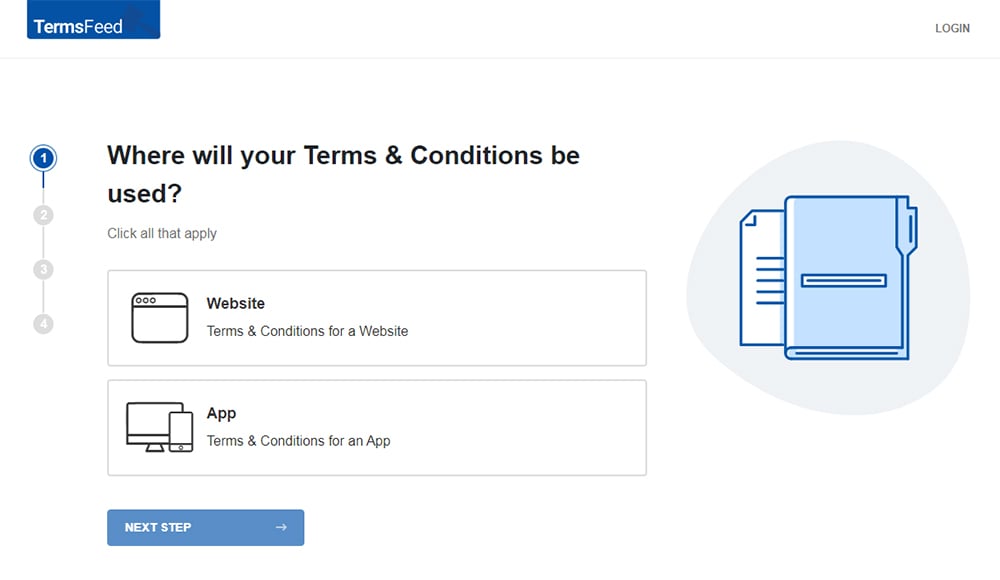
-
Answer some questions about your website or app.
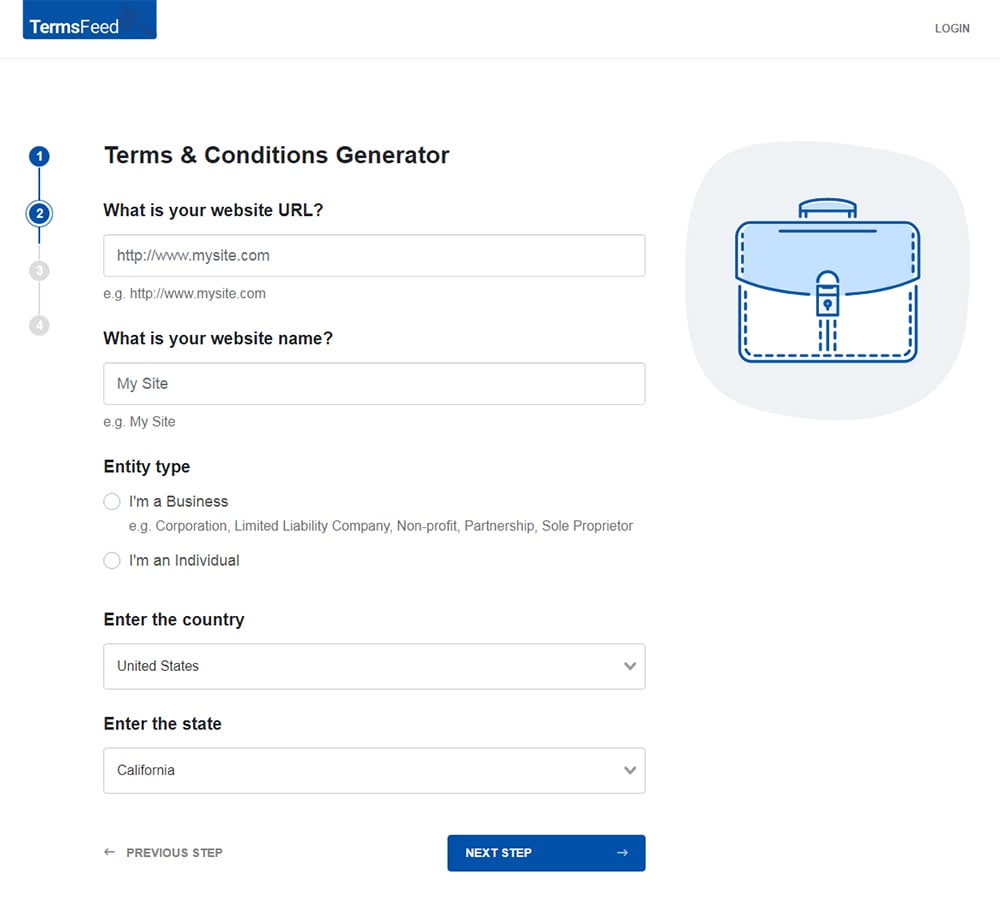
-
Answer some questions about your business.
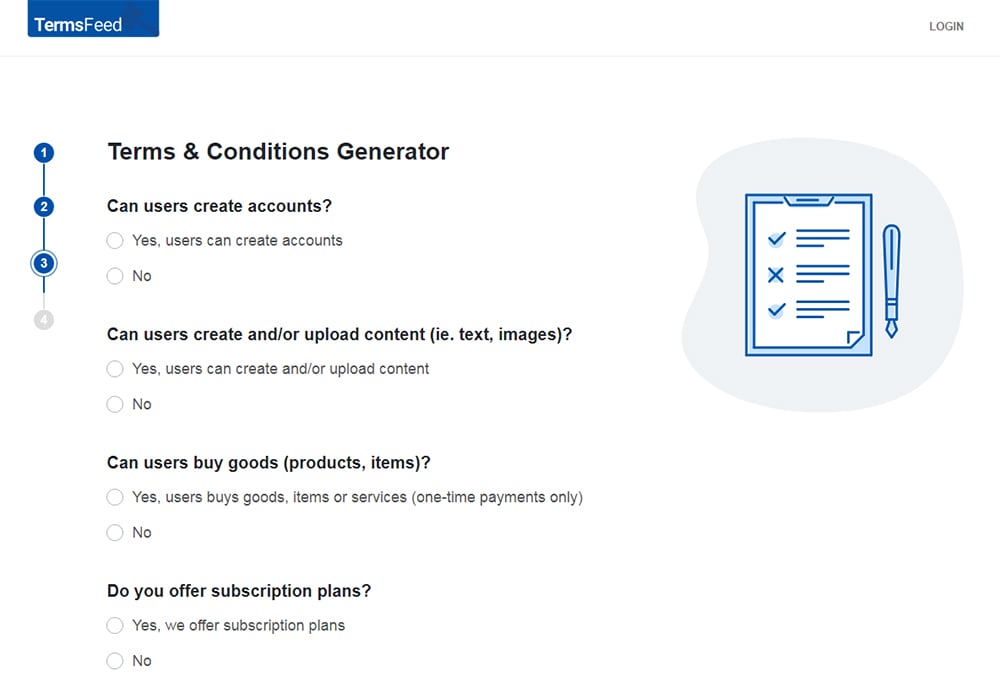
-
Enter the email address where you'd like the T&C delivered and click "Generate."
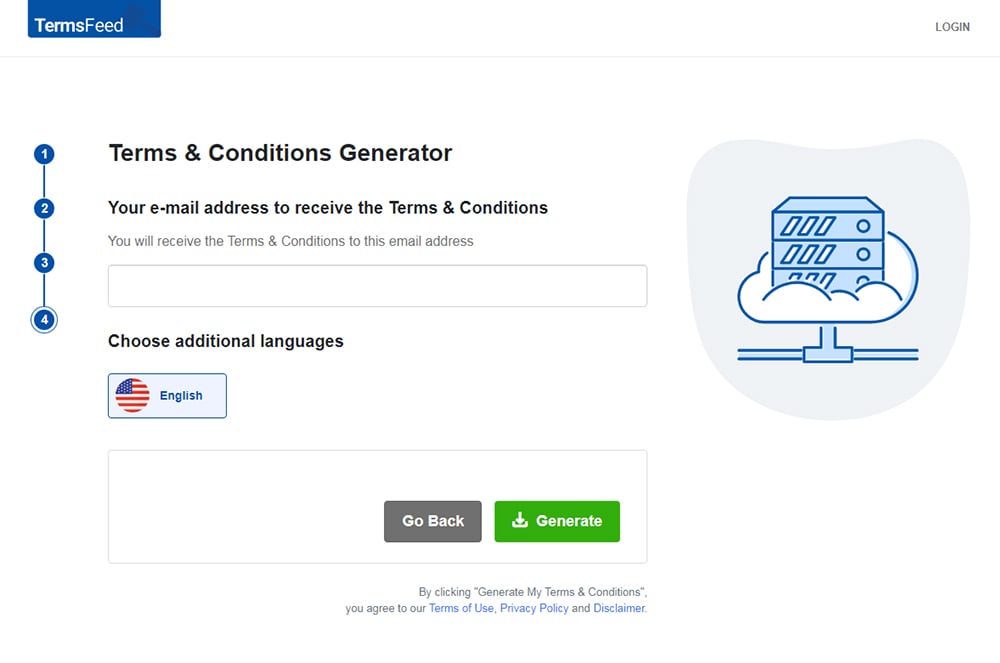
You'll be able to instantly access and download the Terms & Conditions agreement.
- 1. Why Personal Websites Should Have a Terms and Conditions Agreement
- 2. Protections Provided by a Terms and Conditions Agreement
- 2.1. Prevents Abuses of Your Site
- 2.2. Protects Intellectual Property
- 2.3. Provides Grounds to Terminate User Accounts
- 2.4. Reduces Your Legal Liability
- 3. Important Clauses for Personal Website Terms and Conditions Agreements
- 3.1. A Clause Referring to Your Privacy Policy
- 3.2. Authorized Users
- 3.3. Governing Law
- 3.4. Limitation of Liability and Other Disclaimers
- 3.5. Intellectual Property and Copyright Clause
- 3.6. Advertising, Endorsements and Affiliates
- 3.7. Payment Terms
- 3.8. Termination Clause
- 3.9. Notification of Changes to Your Terms and Conditions Agreement
- 3.10. Your Contact Information
- 4. Do I Need a Lawyer to Write my Personal Website's Terms and Conditions Agreement?
- 5. Displaying and Getting Consent to Your Terms and Conditions Agreement
- 6. Summary
Why Personal Websites Should Have a Terms and Conditions Agreement
Most of the time, when you see websites that have a Terms and Conditions agreement, they're more of a business site in nature. In other words, they're not usually seen on an individual's personal website.
However, this can be a huge mistake and oversight.
Terms and Conditions agreements are a vital part of controlling your website, whether you run it as a business or as an individual. These agreements offer you protection and enforcement powers that may not be available if you proceed without one.
Protections Provided by a Terms and Conditions Agreement

Terms and Conditions agreements are not required by law in any jurisdiction, but they are legally binding contracts.
Here are a few ways a Terms and Conditions agreement protects your personal website:
- Prevents abuses of your site
- Protects your intellectual property
- Allows you to terminate abusive accounts
- Limits your legal liability
Let's take a look at each one of these a bit more in detail.
Prevents Abuses of Your Site
Abusive use of your website includes harassing behavior like derogatory content, spamming other users, and stealing intellectual property.
Thus, part of your Terms and Conditions agreement should list what is not allowed on your website.
Here's an example of a clause in a Terms agreement that describes what isn't allowed:
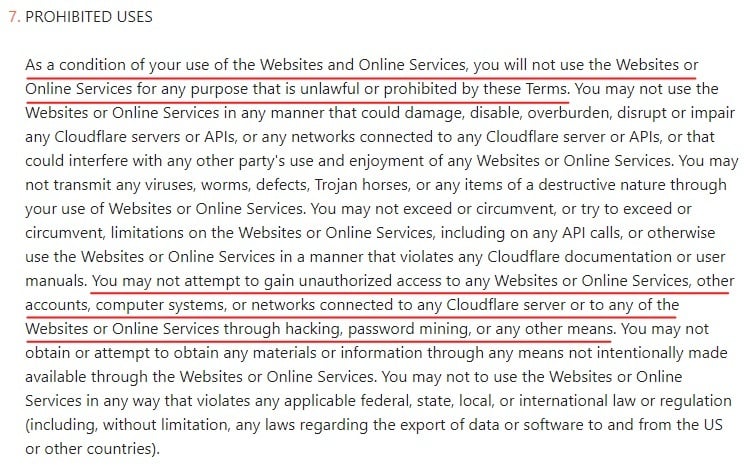
This is especially important if your website encourages interaction between users and user-generated content. You could lose visitors if people do not feel safe communicating on your site.
At the very least, you want to prevent the following:
- Spamming of users
- Privacy breaches
- Infecting your system with viruses
- Intellectual property infringement
- Inappropriate commercial activities
See the following example of a clause limiting certain types of abusive behavior:
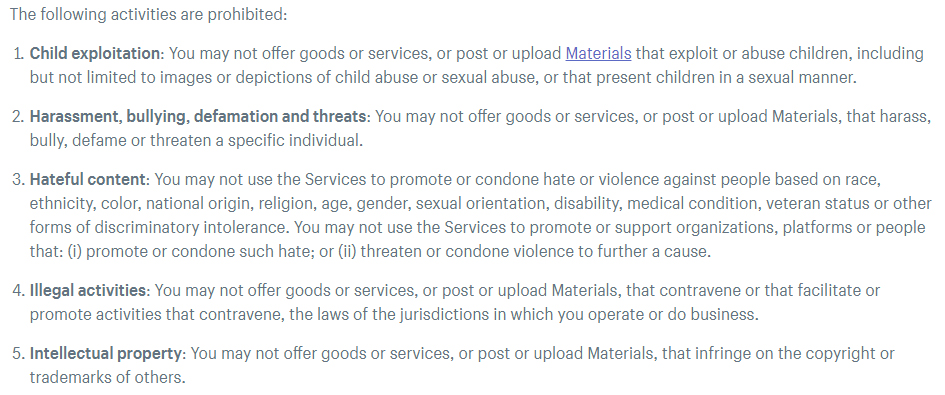
Having a clear policy against abusive behavior can create a safe environment for all users and encourage healthy interactions.
Protects Intellectual Property
Your website likely contains several unique elements that help distinguish it from other sites on the internet. These may include custom graphics, logos, content, and even music.
While these elements can help to make your site more engaging and memorable, they can also be susceptible to theft by users.
To help protect your intellectual property, it is important to include provisions in your website's Terms and Conditions agreement that state these items belong to you and that any infringement may result in legal action against the infringer.
Here's an example of what you can include in your agreement to help protect your intellectual property:

In addition, you may want to consider including a clause that allows you to terminate a user's account in the event of any attempted theft of content or other violations.
By taking these steps, you can help safeguard your website's unique elements and prevent them from being used without your permission.
Provides Grounds to Terminate User Accounts
One of the most common enforcement measures for a personal website's Terms and Conditions agreement is the ability to terminate accounts. That action allows you to remove problematic users and keep your online community safe and free from abuse.
Here's a great example of a detailed clause that reserves the right to terminate accounts, and outlines what behaviors may trigger a termination:
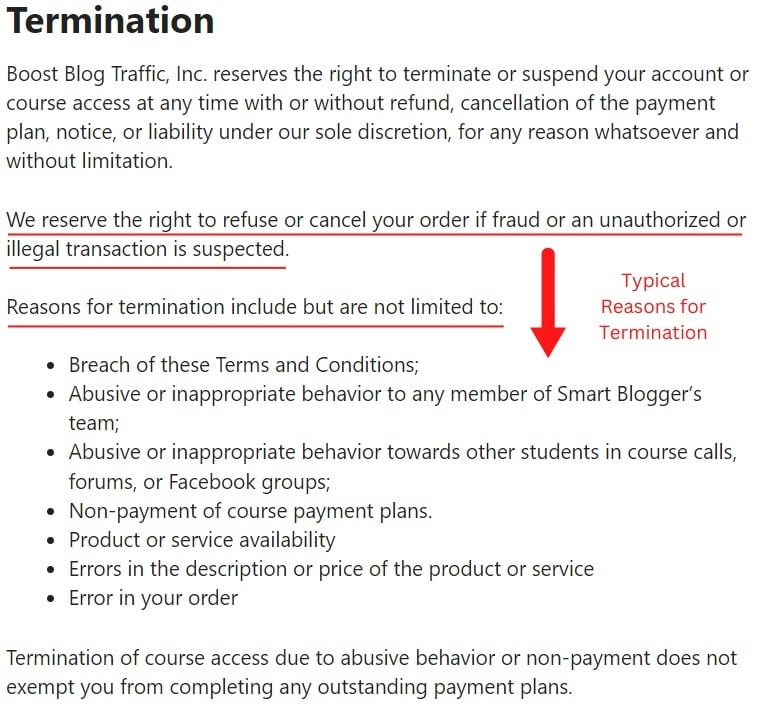
Reduces Your Legal Liability
Most businesses will have Terms and Conditions agreements in place to help protect them from liability if something goes wrong. However, if you are not planning to incorporate your business, or you simply have a personal website, these clauses become even more crucial.
While you cannot waive liability for privacy breaches, you should disclaim losses and damages caused by viruses, technical failure, and any other losses incurred by users or third parties as a result of using your website.
Here's a clause that you could add to a Terms agreement to help limit your liability:

At the end of the day, it's crucial to minimize your risk in the event that something goes wrong. Including a clause limiting liability will give you the best chance of avoiding personal financial loss.
Important Clauses for Personal Website Terms and Conditions Agreements

Where do you start when it comes to writing your own Terms and Conditions for your personal website?
First, consider your reasons and priorities for having a Terms and Conditions agreement. Whatever your reasons, make sure they're clearly reflected in your agreement. Once you understand your goals well, you can start drafting specific clauses.
Below are some of the most commonly seen as well as important clauses in a T&C.
A Clause Referring to Your Privacy Policy
You should have a clause that mentions your Privacy Policy within your Terms and Conditions agreement. This works as reassurance to users that their privacy rights are being respected. All you need to do is note that you have a Privacy Policy and link to it from your Terms and Conditions page.
Here's an example of how this can be done on a personal website:

Authorized Users
Typically, you only need to include this clause to ensure that only specific demographics use your website. Most personal websites won't need it.
However, say you write fiction or poetry that's geared toward a more adult audience. You might then restrict authorized users to visitors over a specific age.
In a case like this, an authorized users clause would be legal protection if a minor came across your website and read its contents.
Here's an example:

Governing Law
It is important to specify which jurisdiction's laws will govern the agreement. This is known as a governing law clause, and it helps to prevent disputes from being resolved in a court far from either party's home base.
For example, if an Austin, Texas company were to enter into a contract with a New York company, specifying that Texas law would govern the agreement would protect the Austin-based company from being dragged into a New York court.
Here's an example of a governing law clause:

Limitation of Liability and Other Disclaimers
It's essential to have a limitation of liability clause in your Terms and Conditions agreement in order to protect your company from potential legal action.
Without a liability clause, your users could pursue damages for shutdowns, viruses, and failure of your app, website, or software. Even if you don't anticipate any issues, it's often what you never expected that gets your company in legal trouble.
Including a liability clause in your agreement can help avoid costly legal action and safeguard your reputation.
Here's how a website could present this clause, in standard all-caps:
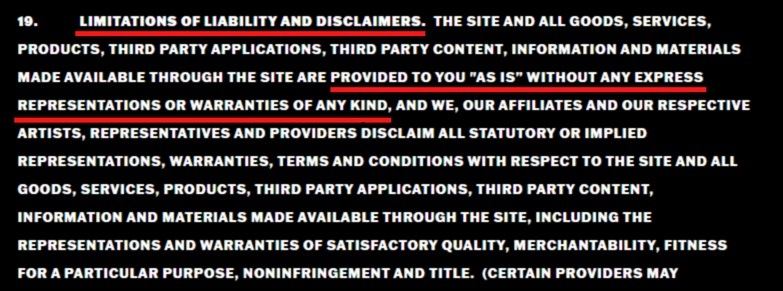
You may need or want to include other disclaimers, such as one of the following:
- Affiliate disclaimer
- Views expressed disclaimer
- No professional advice disclaimer
Just remember that disclaimers work to limit your legal liability and keep your users informed of different important points of such topics.
Intellectual Property and Copyright Clause
When you create a personal website, app, or service, you are also creating intellectual property. This may include trademarks, copyrighted material, proprietary algorithms, and other elements that make your site, app, or service unique.
Anyone with access to your site will also have access to this intellectual property.
If someone uses your intellectual property without permission or a license, they are committing infringement. This is actionable under law and can result in damages being awarded to you.
Therefore, including an intellectual property section in your Terms and Conditions agreement is essential for protecting your business and ensuring that your website's visitors respect your intellectual property rights.
Here's how a site could include information about its copyright policy, intellectual property rights, and how it handles people who violate either:
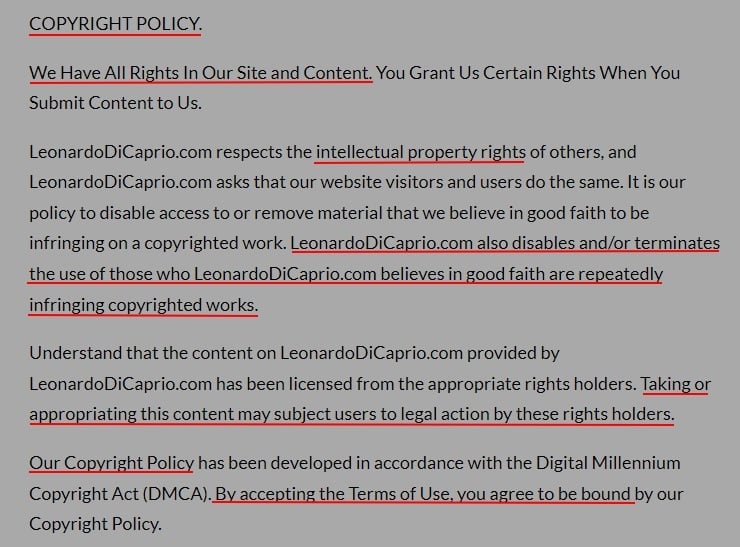
To help avoid liability, you should have a copyright infringement clause that includes:
- A statement that copyright infringement is not tolerated
- Information about how to report copyright infringement (including contact information)
- A statement that anyone who repeatedly infringes on copyright will have their access to your site removed
Finally, you may want to include a disclaimer that you're not responsible for any user-generated content on your site and that all users are responsible for ensuring that their content doesn't infringe on someone else's copyright.
Advertising, Endorsements and Affiliates
Many people monetize their personal websites and blogs with various types of advertisements, endorsements, and affiliate marketing links.
There are specific rules governing each, and it's crucial to include a clause concerning them within your Terms and Conditions agreement.
When you allow third-party advertisers to place ads on your website, disclosing those relationships to your visitors is important and in most cases, legally required.
Even if you're not being paid for the ads, your relationship with the advertiser could create a potential conflict of interest. By disclosing those relationships, you can help visitors make more informed decisions about whether to click on the ads.
In addition, disclosing your connections to third-party advertisers can help limit your liability in case something goes wrong with the ads.
The same holds true for affiliate marketing relationships.
You need to make an announcement or disclosure whenever you promote a product. The affiliate disclosure should be clear, conspicuous, and easy to find. A disclosure does not necessarily have to be placed alongside every affiliate link but should appear on every page on which you have included affiliate links.
You should also include it somewhere within your Terms and Conditions agreement, or even on its own separate disclaimer page.
Here's how April Snow, the Sensitive Therapist does this on her site:

An affiliate disclosure might look something like this:
"I am an affiliate for [COMPANY NAME]. This means that if you click on a link and purchase the product, I will receive a commission. I only recommend products that I have personally used and enjoyed myself."
Payment Terms
Most personal websites won't need a clause on payment terms.
However, if you have a section of your website that acts as an ecommerce store and you sell merchandise, or if your personal website doubles as a freelancing business site, you'll want to include a clause on your payment terms.
Payment amounts do not need to be included in the Terms and Conditions agreement. Having a separate page that covers your price points and fees is sufficient.
This also removes the obligation to change your Terms and Conditions agreement when prices are adjusted, or new services are offered.
Here's how you can do this:
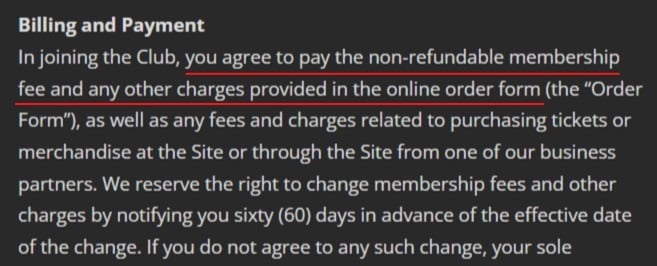
Termination Clause
The termination clause in your Terms and Conditions agreement protects you by allowing you to terminate accounts that violate your agreement. This clause also allows you to terminate accounts for any other reason you see fit.
If you include a termination clause in your Terms and Conditions, specify what constitutes a violation of your terms so that users are aware of what they need to do to avoid having their account terminated:
Here's an example of this:
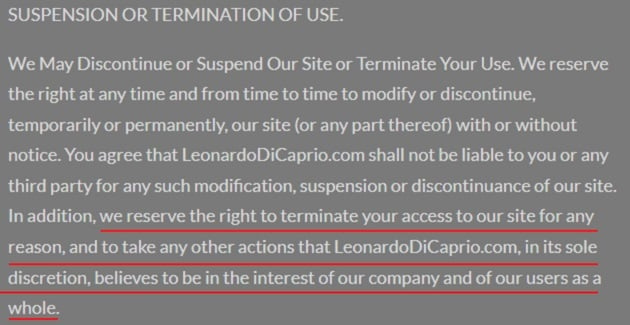
You should always reserve the right to terminate any account for any reason you see fit, just to give yourself that leeway into maintaining control over your website.
Notification of Changes to Your Terms and Conditions Agreement
The longer you have an active, personal website, the more likely your Terms and Conditions agreement will change in line with your business changes. This is common, and users generally expect it.
However, you still need to preserve your authority to make these changes. You can do this via a clause in your Terms and Conditions agreement.
By including a clause that allows you to make changes as needed, you can ensure that you always have the ability to adapt to new situations. Additionally, this clause can help build trust with your users by showing that you are transparent about your intentions.
Here's an example:

Your Contact Information
Most people don't take the time to read through all the fine print in a Terms and Conditions agreement before clicking "agree" or choosing to go on and use your website.
As a result, they may not be cognizant of all the terms to which they agree.
To avoid misunderstandings, it's a good idea to include a statement at the end of your Terms and Conditions that invites users to contact you if they need clarification on anything.
This helps ensure everyone is on the same page and reduces the risk of legal problems down the road.
Here's an example from Ben Settle's website:
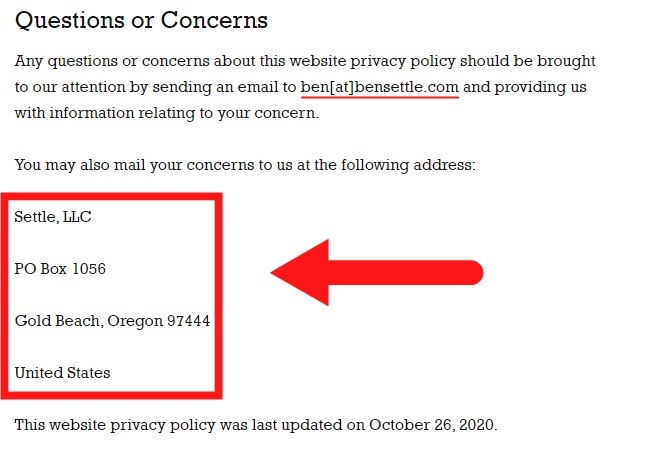
Simply including a phone number or email address can go a long way toward fostering a better understanding between you and your site's visitors.
Do I Need a Lawyer to Write my Personal Website's Terms and Conditions Agreement?

When it comes to your Terms and Conditions agreement, you may be wondering if you need a lawyer to help you write it.
The answer is "probably not." Most personal websites don't have the complexity of a business's scale and context. However, you will still want to legally protect yourself for all the reasons outlined throughout this article.
With that in mind, you can use a customizable Terms and Conditions generator to create a valid agreement.
This generator can help you fill in the basic details and language of your agreement. You can edit it to ensure it covers all of the bases we've discussed here.
If you're not comfortable with that or want a more comprehensive solution, you can always consult with an attorney. But for most personal websites, using a generator is a perfectly viable option.
Displaying and Getting Consent to Your Terms and Conditions Agreement

Because a Terms and Conditions agreement is a legal contract between you and your users, it makes sense that you will need to get consent/agreement from your users in order to enforce the contract. It also must be adequately displayed and easy for the public to find and access at any time.
Your Terms and Conditions agreement should be displayed in your website's footer, as this area is accessible from every page of your site.
Here's an example of how this can look:

You can also display it as a link where you allow users to create accounts, if you have such a feature. This is also a great time and place to request consent, as well.
Here you can see the Terms agreement displayed at the same time users are creating an account, and part of the process is to check a box to agree to the terms:
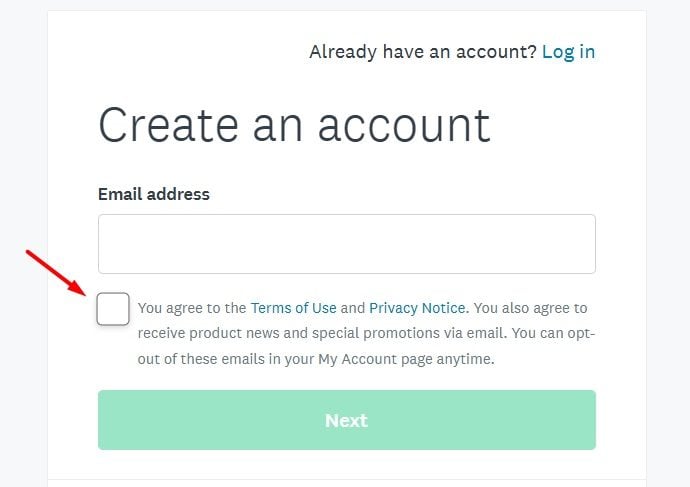
The most common way to guarantee acceptance of your Terms and Conditions agreement is through clickwrap. This requires users taking a clear step to accept the terms, often by clicking an "I Agree" checkbox.
Here's an example:
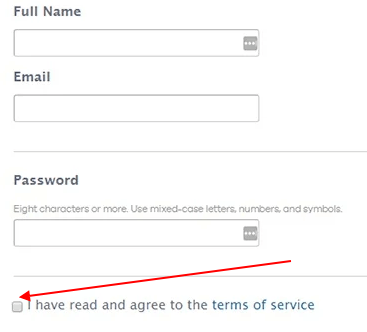
You can also use it with other types of agreements, such as Privacy Policies and Cookies Policies.
Another less used, not-recommended method is called browsewrap.
Browsewrap typically appears as a notification when a visitor first lands on your website. The user is assumed to have accepted your Terms and Conditions agreement simply by accessing and using your website.
However, browsewrap is generally considered less effective than clickwrap, as it does not require the user to take any positive action to signify their acceptance.
Moreover, many personal website owners forgo using clickwrap and browsewrap because users don't need to create an account before browsing the site. If that's the case, it is still considered a best practice to have a Terms and Conditions agreement and to post a link to it within your website's footer.
Here's an example of this:

Summary
While a Terms and Conditions agreement isn't legally necessary, it's highly recommended, even for personal sites.
Having a Terms and Conditions agreement on your personal site will help you:
- Build trust with your readers/site visitors
- Set out important information that your users will want to know
- Limit your legal liability for errors, omissions or copyright issues with your site
- Allow you to maintain better control over your site
Use a trusted generator to create your Terms and Conditions agreement and make sure to use a clickwrap method of getting users to accept your agreement.

Comprehensive compliance starts with a Privacy Policy.
Comply with the law with our agreements, policies, and consent banners. Everything is included.
